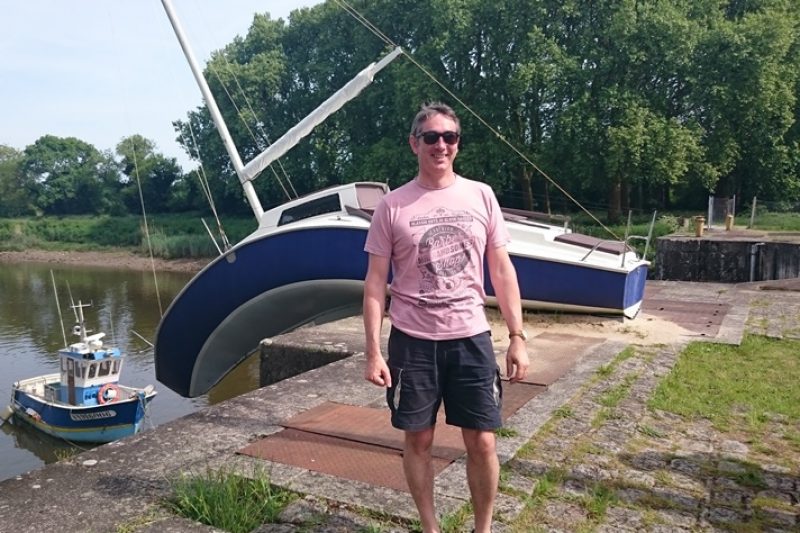Conor Power takes a look at the vibrant western city of Nantes from a fluvial point of view
Nantes has never been afraid of change – it’s no coincidence that it’s the birthplace of Jules Verne; a man whose wacky creations allowed the imaginations of so many around the world run riot over 100 years ago.
The Loire and the Erde Rivers flow into this city and both rivers used to feature even more prominently here. Photos of Nantes from 1920 show that many of those wide boulevards were waterways – canals and branches of the Loire or the Erde. In the 1930s, the local authorities decided that it would be best for Nantes if they filled in lots of them.

Many buildings in the city centre (such as this one where the Boulangerie d’Antan stands on Rue de Verdun) show signs of settlement after the canals and rivers were filled in
There’s another 60km or so between here and the sea at Saint Nazaire. It’s an area that many locals have grown used to seeing as mundane and redolent of the demise of the once-vital body of water linking the city to the Atlantic, but over the last decade, it too has undergone a renewal treatment of great expense and equally impressive artistic merit.
The decision was made to install permanent works of art in Nantes, Saint Nazaire and along both banks of the estuary. These are all free to access all year round and the idea is that you can visit them by car, by bike or even on foot.
The Estuaire project is a story that unfolded in three episodes: In 2007 and 2009, about 30 works were commissioned and carried out in situ. Some of these were temporary and some were permanent. The choice of sites was made on the basis that almost every commune along the river would have at least one work of art and the last of them were completed in 2012.If there’s any common theme running through it, it seems to be to intrigue and to catch the eye. It’s a way of making you explore the towns of the estuary, stop, look around and have a think about what this place was and what it will be. Artists were commissioned without (apparently) being tight on the purse-strings and on the merit of their work, no matter what the nationality or location.
Thus, there are several nationalities involved here and we set out to see a few of them along the north and south side of the Loire.

Room to let… Tatzu Nishi shows how to make a little house on top of a truncated chimney blend into the landscape
You can even get inside it if you’re there between the hours of 2 and 4pm on a Sunday. That is to say, you can climb the staircase and up to the garden area on top to admire the view. Access to the house itself is only possible if you want to rent it out, which you can do via Nantes Tourisme. It’s one of the few artistic pieces that actually generates a regular income, with a waiting list to stay the night in a little house by the river on top of a truncated chimney.
Among the most alarming-looking pieces is the one called La Maison dans la Loire by French artist Jean-Luc Courcoult (one of the main men behind street theatre company Royal de Luxe, whose giant granny visited Limerick last year). Essentially, it’s a house that appears to have been caught up in a flood, uprooted and sitting askew on the river bed, waiting for the next surge of water to carry it out to sea. The effect is really good, with the artist using real building material and a replica of a real house to create the illusion. If you had known nothing about it at all, you could just imagine yourself fishing by the pier one day and peering across the stretch of water wondering “What the hell happened to that house?”
One of my favourites was the piece Misconceivable (see goofy pose in main pic). It’s a very photogenic one by Austrian artist Erwin Wurm, who gave his work the clunky English title. Using a real boat that had no more use for the sea, he gave it a new lease of life by getting it to physically bend and look like it was struggling to return to the sea from the old inner harbour where it sits at the edge, straining to make the final drop into the water.Personally speaking, I’m not one for lingering in art galleries: after about 20 minutes, I’m looking around for the exit with the promise of a pub beyond. Art in the open air can be a hit-or-miss affair but the Estuaire project is superb. You can see pretty much all the pieces in one day if you have a car but if you’re wise, you’ll take your time and see what you can see, have a think, have a look at places that you might otherwise simply pass by. You can always go to the pub later.
For a quick an quirky atmospheric tour of all the pieces, check out this short film below – “Estuaires”, by Gaëtan Chataignier.
Aer Lingus fly three times weekly from Dublin to Nantes; Tuesday, Thursday and Saturday. Flights operate to 12th September 2015. Fares start from €59.99 one-way including taxes. For more information on fares and schedules visit aerlingus.com
Further links on Nantes:
Le Voyage à Nantes (great tourism website)
Rendezvouenfrance.com (Official French tourism website)






 Tootlafrance is Ireland’s fresh new eyes on France, bringing you the latest news, exclusive celebrity interviews, political analysis, cultural events, property news and, of course, travel features written by top Irish journalists.
Tootlafrance is Ireland’s fresh new eyes on France, bringing you the latest news, exclusive celebrity interviews, political analysis, cultural events, property news and, of course, travel features written by top Irish journalists.